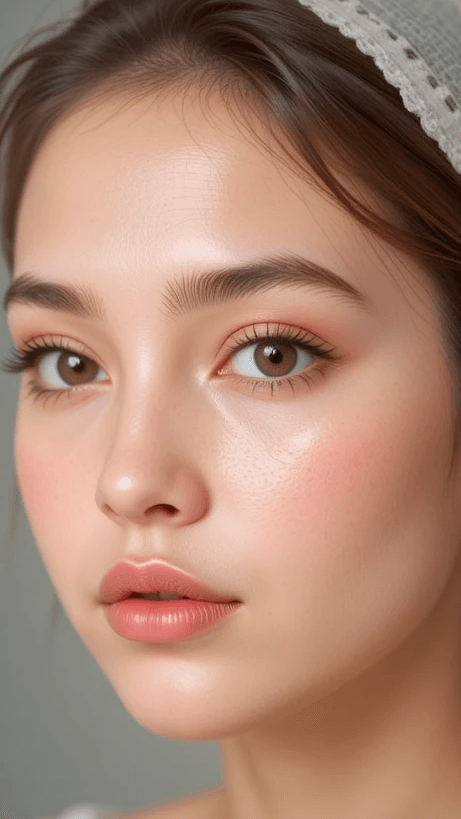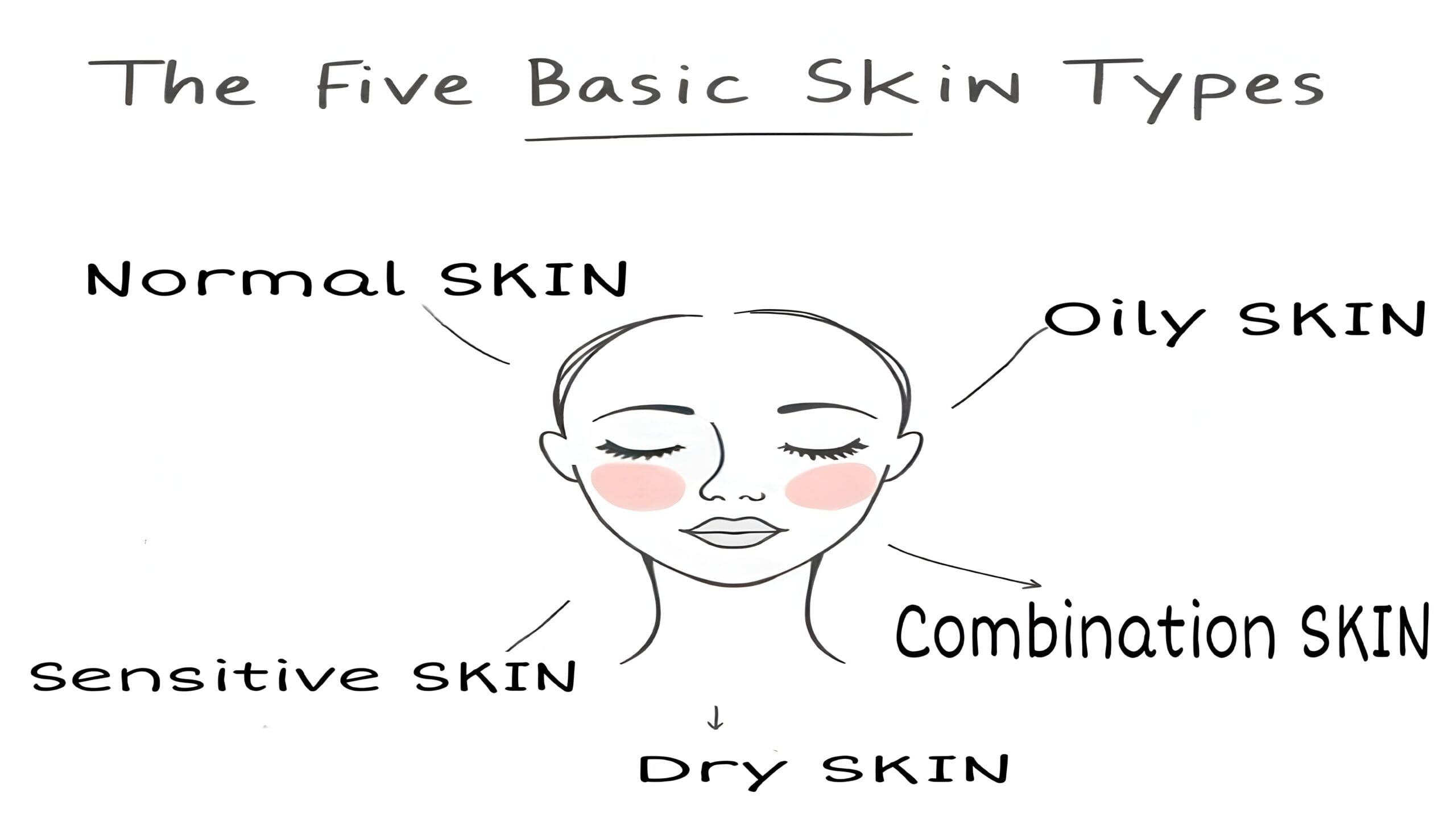Ever wondered why some skincare products work wonders for your friend but do nothing for you? It’s all about understanding your own skin. When you Identify your skin type, you unlock the secret to choosing the perfect products and achieving that healthy, radiant glow.
The Five Basic Skin Types
Recognizing your skin type is essential for crafting a skincare routine that truly benefits you. The American Academy of Dermatology identifies five primary skin types: normal, oily, dry, combination, and sensitive. Each type has distinct characteristics and requires specific care. Let’s delve into these categories to understand their unique traits and the reasoning behind their names.
Normal Skin
Characteristics: This skin type boasts balanced moisture levels, fine pores, and a smooth texture. It doesn’t lean towards being too oily or too dry, presenting a well-balanced state.
Why is it named this way ?. The term “normal” is used because this skin type represents a state of equilibrium, free from significant skin concerns. It’s considered the standard or baseline against which other skin types are compared.
Oily Skin
Characteristics: Oily skin is marked by excess sebum production, leading to enlarged pores and a shiny appearance, especially in the T-zone (forehead, nose, and chin).
Why is it named this way ? The designation “oily” stems from the overproduction of sebum by the sebaceous glands. This surplus oil gives the skin a greasy sheen and can contribute to acne development.
Dry Skin
Characteristics: Individuals with dry skin experience a flaky, rough texture, a tight feeling, and possible itchiness. The skin may appear dull and lackluster due to insufficient moisture.
Why is it named this way ? .Dry” indicates a lack of adequate hydration and natural oils in the skin. This deficiency can compromise the skin’s barrier function, making it more susceptible to environmental factors.
Combination Skin
Characteristics: Combination skin exhibits both oily and dry areas. Typically, the T-zone is oily, while the cheeks and other parts of the face are either dry or normal.
Why is it named this way ?. The term “combination” reflects the coexistence of multiple skin types on different areas of the face. This mixed condition requires tailored care to address the varying needs of each zone.
Sensitive Skin
Characteristics: Sensitive skin is prone to redness, irritation, and adverse reactions to certain products or environmental factors. It often requires extra care to prevent discomfort.
Why is it named this way ?. “Sensitive” denotes the skin’s heightened reactivity to external stimuli. This increased sensitivity can result from a weakened skin barrier or an overactive immune response.
Understanding these skin types and their nomenclature helps in selecting appropriate skincare products and routines. By identifying your specific skin type, you can tailor your skincare approach to maintain healthy and radiant skin.

Methods to Determine Your Skin Type
To identify your skin type, begin by cleansing your face with a mild cleanser and gently patting it dry. Avoid applying any skincare products and wait for approximately one hour.
After this period, carefully examine your skin for characteristics such as oiliness, dryness, or a combination of both. This simple test helps you understand your skin’s natural behavior and choose the right products for its needs.
- If it appears shiny all over, you likely have oily skin.
- If it feels tight or flaky, you probably have dry skin.
- If it’s shiny in the T-zone (forehead, nose, and chin) but normal or dry elsewhere, you may have combination skin.
- If it feels balanced and comfortable, you likely have normal skin.
- If you notice redness or irritation, you might have sensitive skin.
Alternatively, you can use blotting papers to gently press on different areas of your face. Afterward, examine the oil residue on the sheets:
- High oil content indicates oily skin.
- Little to no oil suggests dry skin.
- Oil in the T-zone only points to combination skin.
By understanding these signs, you can better identify your skin type and choose products that cater to your specific needs.
Factors Influencing Skin Type
Your skin type is shaped by a combination of internal and external factors. Genetics, age, hormonal changes, climate, and lifestyle habits (like diet and stress levels) all play a significant role in determining whether your skin is oily, dry, combination, or sensitive. Understanding these influences can help you tailor your skincare routine for optimal results.
- Genetics: Your inherited traits play a significant role in determining your skin type.
- Environmental Factors: Climate, pollution, and exposure to elements can affect your skin’s condition.
- Lifestyle Choices: Diet, stress levels, and sleep patterns influence your skin’s health.
- Hormonal Changes: Life stages such as puberty, pregnancy, and menopause can alter your skin type.
Building a Skincare Routine Based on Your Skin Type
Once you’ve identified your skin type, you can tailor your skincare routine accordingly. Here’s a general guideline:
- Cleansing: Use a cleanser suitable for your skin type to remove impurities without stripping natural oils.
- Toning: Apply a toner to balance your skin’s pH and address specific concerns.
- Moisturizing: Hydrate your skin with a moisturizer that matches your skin’s needs. For instance, gel-based moisturizers work well for oily skin, while cream-based ones are better for dry skin.
- Sun Protection: Apply a broad-spectrum SPF daily to protect against UV damage, which can exacerbate skin issues.
Common Misconceptions About Skin Types
When it comes to skincare, there are several myths that can lead to confusion and improper care. One common misconception is that “oily skin doesn’t need moisturizer.”
This is far from true. All skin types, including oily skin, require hydration. Skipping moisturizer can actually trigger your skin to produce even more oil as it tries to compensate for the lack of moisture, leading to a vicious cycle of excess shine and potential breakouts. Instead, opt for a lightweight, non-comedogenic moisturizer that hydrates without clogging pores.
Another widespread belief is that “natural products are always safe for sensitive skin.” While natural ingredients can be beneficial, they are not universally gentle. Some natural components, like essential oils or citrus extracts, can cause irritation or allergic reactions, especially for those with sensitive skin. It’s crucial to patch-test any new product before full application and monitor your skin’s response over 24-48 hours.
Additionally, many people think “dry skin only needs heavy creams.” While dry skin does require richer formulations, overloading it with thick products can sometimes suffocate the skin and hinder its natural repair processes. Balancing hydration with lightweight layers of moisture is key.
Lastly, the idea that “acne-prone skin should avoid all oils“ is misleading. Not all oils are created equal. Non-comedogenic oils like jojoba or squalane can actually help regulate sebum production and maintain the skin’s barrier function.
Accurately identifying your skin type is the first step toward effective skincare. By understanding your skin’s unique characteristics, you can select products and routines that enhance its health and appearance. Remember, your skin may change over time due to various factors, so it’s essential to reassess your skin’s needs periodically.
Frequently Asked Questions
Can my skin type change over time?
Yes, factors like age, environment, and lifestyle can alter your skin type.
Is it possible to have different skin types on different parts of my face?
Yes, this is characteristic of combination skin.
Is it possible to have different skin types on different parts of my face?
Yes, this is characteristic of combination skin.
How often should I reassess my skin type?
It’s advisable to evaluate your skin every few months or when you notice significant changes.
Can using the wrong products harm my skin?
Yes, products not suited to your skin type can cause issues like breakouts or dryness.
Are professional consultations necessary for determining skin type?
While home methods are effective, consulting a dermatologist can provide personalized insights.




